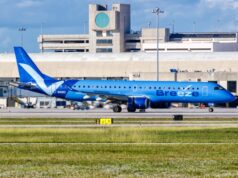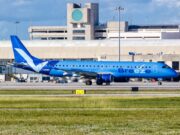
VMC
VMC (minimum controllable airspeed) is probably a concept foreign to you unless you have flown a multi-engine aircraft. VMC is the speed below which aircraft control cannot be maintained if the critical engine fails under a specific set of circumstances. (See 14 CFR part 23.) Each aircraft has its own VMC marked on the airspeed indicator, corresponding to a red line. Criticality of VMC pertains to a potential engine failure. If an engine fails, directional control is affected, resulting in a directional yaw towards the inoperative engine. If the critical engine fails, expect the yaw to be maximized.
To ensure pilots are able to maintain directional control, a VMC “demo” is exhibited by flight instructors for their students. Then, students perform the maneuver until satisfactory proficiency is achieved. Remember a Vmc demo will be required to be tested during the FAA practical test. Several factors can aggravate a VMC situation, such as an aft center of gravity, retracted gear, and/or holding wings level. It’s equally important for pilots who fly multi-engine airplanes to remain proficient to handle safely real-world situations.
Angle of Attack Basics
One of the leading causes of general aviation accidents is loss of control in-flight. Stall can potentially lead to the loss of control if the aircraft is not recovered correctly. Regardless of aircraft, a stall is recovered by reducing the critical angle of attack. Stalls can happen during any phase of flight (and at any airspeed). However, they are critical at low altitudes such as takeoffs and landings due to the reduced recovery margin. Recovering from a stall, depending on the specific scenario, can lead to significant altitude loss.
Often, we associate stalls with airspeed. Stall speed changes and is not fixed. Load factor, configuration, and weight all affect stall speed. Hence, it is important that pilots identify the onset of a stall promptly. Some aircraft are equipped with visual and aural cues, known as angle of attack (AOA) indicators. These devices are a more reliable indication of airflow over the wing, regardless of its configuration. Without it, angle of attack is essentially invisible to pilots. An AOA indicator can be used to get the pilot’s attention (via audio cues and/or low-cost stick shakers) even if the pilot is not looking, prompting an early recovery. Finally, it is important to note each aircraft handles differently aerodynamically. Stall onsets may produce tactile cues such as vibrations and sluggishness of controls, among others. These may vary by equipment, and you may not be familiar with them if you are unfamiliar with the aircraft you are operating. In such cases, AOA indicators become even more important. For aircraft owners, these after-market indicators are now more available and affordable, allowing them to be retrofitted if an aircraft is not equipped with one from factory. A negative aspect to them is “over-reliance.” As electronic equipment, they are prone to failure and have their own limitations, hence the importance of the tactile aerodynamic cues of an impending stall being perceived by the pilot.
Over 20% of general aviation accidents include loss of control due to stalls, spins or other factors such as VMC events (applicable to multi-engine aircraft). Understanding the aerodynamics and the theory behind these events is the first step in preventing them from developing into an accident. Become familiar with equipment on board your aircraft, such as angle of attack indicators, to increase your situational awareness. As a multi-engine pilot, be sure to perform practice Vmc events regularly with an instructor in order to stay proficient. Doing so may save your life in the event of an engine failure.






















































































































